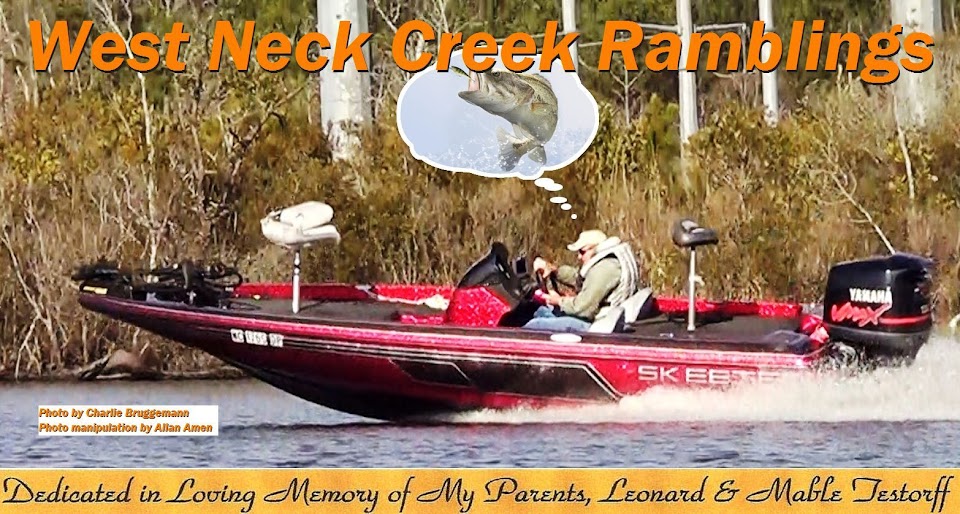Saturday, March 11, 2017
No Matter How You Spin It, a Spinnerbait in Spring Is Hard to Beat
When I first heard those two reports this past Thursday about some guys catching a lot of fish with spinnerbaits, I had flashbacks to the year when I didn't fish anything but spinnerbaits from start to finish. I carried "tons" of those baits--in every blade style and size, varying colors, different weights, etc.--all season long, and, yes, I caught lots of fish with them.
I still carry a few spinnerbaits in my tackle bag but only rarely throw one these days. More than anything else, I have to admit that I've lost confidence in them--a problem that, as revealed in my Internet research, is common among a number of anglers.
According to bass pro and fishing guide Larry Wilcox, though, "The spinnerbait is (or should be), without question, the primary weapon in your arsenal, whether you are competing in a tournament or pleasure fishing. If you don't hone your skills with this bait, you will be left behind at weigh-in," he says. "A spinnerbait can be fished from top to bottom, in clear or muddy water, in thick brush, or on a slick bank. There is no other lure as versatile as the spinnerbait, especially for anyone fishing a tournament."
Wilcox notes that you don't need to spend 200-plus days a year on the water to become proficient with a spinnerbait. However, it's his first choice for finding fish on practice days for tournaments. And for the record, he doesn't "stick" the fish on practice days. He instead cuts off the hook or collapses it against itself.
"The fish will be far easier to catch when you return on tournament day if you don't hook them the day before," he explains. "Bass are generally shallow this time of year, and you can either see or feel most strikes."
So, what can you do to a spinnerbait to add a little more weight to your bag of fish at the tournament scales? Here are some suggestions from Wilcox:
* Use a trailer hook
* Add a rattle or two (especially helpful in muddy water)
* Use outrageous colors or color combinations (especially helpful when there's a lot of fishing pressure)
* Try waking a big-bladed spinnerbait, especially in deep water (works best in clear water with temps in the 60s).
Another pro who relies heavily on a spinnerbait, especially around the prespawn, spawn and post-spawn periods, is Elite Series angler Keith Combs.
"Prespawn is easily my favorite time to throw a spinnerbait," he allows. "The big females suspend up in the water column to sun themselves in cold water. They're not ready to spawn yet, and I generally catch them best around standing timber or over other cover in stained water."
It's Combs' contention that many anglers miss a lot of fish--and heavy ones, at that--by staying with crankbaits and bottom-bouncing baits like jigs when the fish are up in the water column. The spinnerbaits he throws at this time are usually 3/4-oz. models, with a willowleaf-Colorado blade combination, and he slow rolls them. When the bass move to the beds, he shifts mostly to 1/4-oz. models with small blades. These baits, in his words, "give him an advantage over flipping and pitching because he can target a lot of cover on a single cast and find active fish without even having to see them."
At the same time, Combs admits that the spawn still is very situational for spinnerbaits. "I like those dark, cloudy days with some wind when they are bedding for using a spinnerbait," he explains. "It's a lot more effective when you can't sight fish or flip well because of wind."
In the post-spawn, Combs opts for 1/2-oz. spinnerbaits with big blades. He purposely tries to get the fry around bushes and wood cover to scatter, so he can draw the attention of mama.
Combs really beefs up his tackle for spinnerbait fishing around the spring spawn. He likes 25-pound Seaguar Abraz-X when fishing wood cover in the prespawn, then afterward drops down to 20-pound Seaguar Tatsu. He also goes for a stouter rod, namely a Power Tackle PG144, during the prespawn because of the fish being much bigger then. All the rest of the time he uses a medium-heavy Power Tackle PG143, with a 7.3:1 gear-ratio reel.
Although he acknowledges switching to a vibrating or swim jig at times, Combs always comes back to the spinnerbait because he has developed a lot of confidence in it as a springtime big-fish bait.
The months of February, March and April definitely provide the best chance to catch a personal best or citation bass locally. The water then usually is stained, with temps in March running between 40 and 50 degrees, and bass usually are feeding heavily on emerging crawfish, shad and bluegill. Strong winds are the norm this time of year, and big females are increasingly aggressive, as they prepare for the spawn. Those are all ingredients that call for one thing: spinnerbaits.
There are many little tricks that will make this bait the most productive lure you can use this time of year. The variations are limited only by your imagination. The only question you have to ask yourself is this: How big do I want to or dare to dream?
Subscribe to:
Post Comments (Atom)






No comments:
Post a Comment